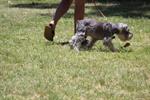 ANIMAL PSYCHOLOGY CERTIFICATE DISTANCE LEARNING
ANIMAL PSYCHOLOGY CERTIFICATE DISTANCE LEARNINGSTUDY ANIMAL PSYCHOLOGY WITHIN THE COMFORT OF YOUR OWN HOME
EXCELLENT TUTOR SUPPORT
UNDERSTAND ANIMAL PSYCHOLOGY
LEARN HOW TO USE PSYCHOLOGICAL TECHNIQUES TO IMPROVE ANIMAL BEHAVIOUR.
Modules
Note that each module in the Qualification -Certificate in Animal Psychology is a short course in its own right, and may be studied separately.
What Do You Think Animals are Really Thinking?
It is easy for you to look into the eyes of an animal and feel that there is a soul trapped inside that body that thinks very much like you do. In reality, this is further from the truth than many people usually like to acknowledge. That said, the Ancient Greek philosophers such as Descartes argued that the fundamental difference between animals and humans is that animals do not have a soul, and this view has persisted since then in Western culture.
Descartes also argued that animals did not think like humans or use reasoning. Instead, he considered their behaviour to be at the mercy of 'mechanistic instincts'. Despite humans having mechanistic movements like animals, and also having some animalistic traits, it was considered that through their ability to reason humans were above animals in the way they behaved.
In contrast to the Ancient Greek philosophers, Charles Darwin in his 'Theory of Evolution' (1859) suggested that there were differences across animal species. By demonstrating similarities between human and animal behaviours, he argued that there were no fundamental differences between humans and animals. Therefore, humans are also animals, we just happen to be more highly developed ones.
Today we often see animals in films or the media which are given human characteristics. This anthropomorphism is widespread. Perhaps it helps us to feel closer to animals. The online Free Dictionary defines anthropomorphism as “Attribution of human motivation, characteristics, or behaviour to inanimate objects, animals, or natural phenomena”. Some well-known anthropomorphic examples include Walt Disney’s 'Cinderella' in which Cinderella has companions who are talking mice. In George Orwell's 'Animal Farm' different types of animals were given different human traits, whereas the rather comical 'Mr Ed' was a talking horse. Films and books have often embellished their animal characters with human characteristics to encourage us to relate to them.
The first step to understanding animal behaviour is to recognise that while there are common behavioural traits that may cross over between species, every species is largely different to other species and none more so than humans. People behave differently to animals, because their mind works differently to animals.
MANAGING ANIMALS DURING FIRST AID
Animal owners and carers will often need to handle animals to inspect them or provide first aid or other health care treatments. For small animals, or less disruptive procedures, managing the animal is not as much of an issue, but in some circumstances, handling them can become a challenge.
Understanding the psychology of animals is the first step toward handling animals in any situation. When you understand how they are likely to react, you can prepare and have contingencies prepared for.
When administering first aid there can be a very real threat of an animal causing further injury to itself and possibly to you.
Restraining it is usually wise, particularly if there is the likelihood of an animal becoming frightened, agitated, or if you are unfamiliar with the nature of the animal being handled.
Restraining may be done with small animals by holding them firmly; but often more is needed than a second pair of hands if a large animal is to be restrained.
Never under rate the possible damage that may be caused by even a small animal, and always be sure to avoid the animal scratching or biting.
Methods of restraining animals may include:
- Holding them
- Putting them on a leash
- Muzzling the mouth
- Tying them down to a table top
- Placing them inside a cage or pen which they cannot turn or move much inside.
- Placing on a slippery surface
- Driving or moving them into a narrow chute
- Tying ropes to, or holding two or more legs and having a different person holding each rope, stretched out so the animal’s movement is restricted in any direction.
- Bribery (eg. Supplying feed)
Why Study Animals?
Animals are an integral part of the human world, and understanding their behaviour is fundamental to living in harmony with animals.
Whether you encounter animals as pets, wildlife or domesticated farm animals; you will undoubtedly encounter them continuously throughout your life.
If you work in the pet farm or wildlife industries; you will not only encounter them; but an ability to understand animal psychology is critical to success or failure in your workplace.
